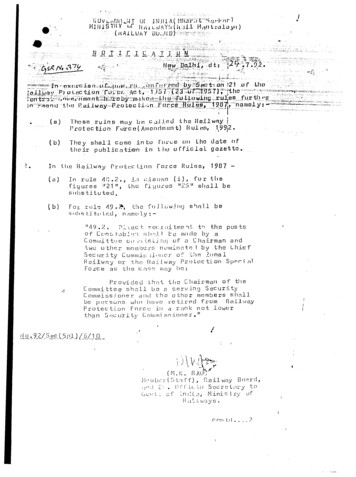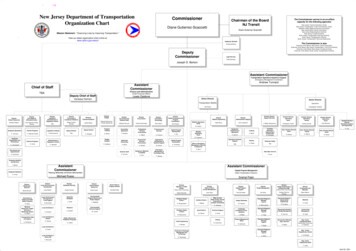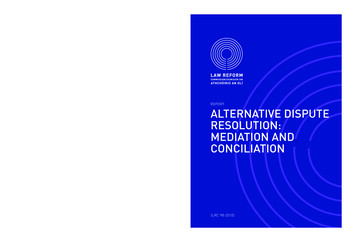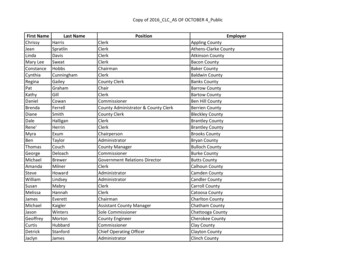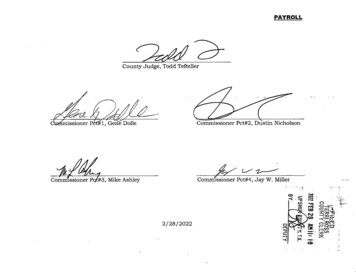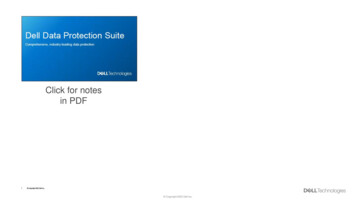Transcription
Guidance Note:Employer Vehicle TrackingMay 2020
Version Last Updated: May 2020ContentsLawfulness of In-Vehicle Tracking . 2Purpose Limitation and Data Minimisation. 3Transparency and the Right to be Informed. 4Data Protection Impact Assessments (DPIA) . 4When is a DPIA Needed? . 5How Should a DPIA Be Carried Out? . 5Practical Compliance Steps to for Employers . 6Employees are entitled to a reasonable expectation of privacy in the workplace as hasbeen established by Article 8 of the European Convention of Human Rights andconfirmed by recent case law in the European Court of Human Rights (ECHR).1 The useof in-vehicle tracking by an employer (‘the controller’) carries a high risk of interferingwith the privacy and data protection rights of the employee.The General Data Protection Regulation (GDPR) and Data Protection Act 2018 (‘the Act’)regulate how personal data may be processed. In the context of in-vehicle tracking, it’simportant to remember that location data qualifies as personal data under the GDPRany time it relates to an identifiable individual.It is therefore important to note that an employer using vehicle tracking is not justcollecting data about the vehicle but also the personal data of individual employeeusing that vehicle, such as location data or potentially even behavioural data about theemployee. In order for in-vehicle tracking to be lawful under GDPR, strict requirementsmust be met by the employer.Vehicle tracking should not be used for the general monitoring of staff. The legitimateaim of using such technology may be to track or monitor the location of the vehiclesused in an employment context, but it is important to note that employers should notregard vehicle tracking as a method to track or monitor the behaviour or thewhereabouts of drivers or other staff.2See Bărbulescu v. Romania (Application no. 61496/08) [2017] ECHR 742See also Opinion 13/2011 on Geolocation services on smart mobile devices, WP 185, 16 May /2011/wp185 en.pdf121
Version Last Updated: May 2020Lawfulness of In-Vehicle TrackingAs a first step employers must be able to demonstrate a legal basis for implementing invehicle tracking. Article 6 GDPR prescribes that any processing of personal data is onlylawful where it is grounded on a legal basis. It sets out what these potential legal basesare, namely: consent; contract; legal obligation; vital interests; public task; or legitimateinterests. Further guidance on the legal bases for processing personal data can befound on the Data Protection Commission’s (DPC) website.In addition to a identifying a legal basis, the employer must ensure that any processingof their employees personal data complies with the principles of data protection laidout in Article 5 GDPR, namely: lawfulness, fairness and transparency; purposelimitation; data minimisation; accuracy; storage limitation; integrity and confidentiality(security); and accountability. Some of these principles are discussed further below,however further guidance on these principles of data protection can be found on theDPC website.Examples of legal bases for in-vehicle tracking may include: compliance with a legalobligation (such as using a tachograph on a lorry) or an employer’s legitimate interest inbeing able to locate the vehicle at any time. Critically, employee consent will only beconsidered an adequate legal basis in exceptional circumstances. This is because of thedifficulty in obtaining ‘freely given’ consent required by Article 4(11) GDPR, given thenature and power imbalance inherent in the relationship between employee andemployer.3 It should be remembered that consent is also revocable at any time at theoption of the employee, and they must not suffer a detriment if they do so.4Many employers may seek to rely on Article 6(1)(f) GDPR as a legal basis for processinglocation data: the necessity to process vehicle location data as a legitimate interest oftheir business. Critically the processing must be strictly necessary and proportionate forthe purpose of achieving that interest, and the legitimate interest being pursued mustbe balanced against the rights and freedoms of the employee, including theirreasonable expectations of privacy.The legitimate interests of the employer to process personal data that is necessary forthe normal development of the employment relationship and the business operationjustify certain limitations to the privacy of individuals at the workplace. However, theseinterests cannot take precedence over the principles of data protection, including therequirement for transparency, fair and lawful processing of data and the need to ensurethat any encroachment on an employee’s privacy is fair and proportionate.34Article 4(11) GDPR and Recital 43 GDPR further explores the meaning of consent.See Recital 42 GDPR2
Version Last Updated: May 2020Tracking data must be limited and restricted to the specific purpose identified, in linewith the principles of ‘purpose limitation’ and ‘data minimisation’ (discussed below), soas not to violate the employee’s data protection rights.Article 21 GDPR provides a right for the employee to object to data processing carriedout on the grounds of ‘legitimate interests’. This would include the right to object tovehicle tracking carried out on those grounds. In the case of objection, the employermay only proceed with the vehicle tracking if it is necessary to achieve a compellinglegitimate interest which overrides the interests, rights and freedoms of the employee.Purpose Limitation and Data MinimisationClosely related to the obligations regarding lawfulness, controllers must also ensure anydata processing meets the obligations of purpose limitation and data minimisation,found in Article 5 GDPR.An employer must ensure they have identified the specific purpose for the dataprocessing at least at the time of collection of the personal data, and in the case ofvehicle tracking the purpose should be identified before the purchase orimplementation of technology which allows such tracking. This purpose must be explicitand legitimate. The data must not be used for other, further purposes that areincompatible with the original purpose used to justify the initial processing.An example of further processing, which would be incompatible with the originalpurpose would be the monitoring and evaluation of employees, where the originalpurpose of collecting the data was for security in the case that a vehicle was stolen.In conjunction with the principle of necessity (particularly important whendemonstrating a legal basis which provides a grounds for processing) and the principleof data minimisation, employers should remember that vehicle tracking should not beused if the purpose cited could be achieved by less intrusive means. Further guidanceon the principles of purpose limitation, data minimisation and further processing can befound here on the DPC website.3
Version Last Updated: May 2020Transparency and the Right to be InformedEmployers implementing in-vehicle tracking must also comply with their transparencyobligations under the GDPR, and ensure they meet the employee’s right to beinformed.5An employee must be informed of the existence of tracking and how it operates as wellas being clearly informed of all the purposes for which their personal data is to be used,in advance of any such tracking being implemented. This means that the employer mustclearly explain to the employee who is using the vehicle concerned what records arebeing created, why those records are necessary, what they will be used for, how longthey will be kept for, who will have access to them and for what reason.It is critical that employees are made fully aware of the extent of the use of the personaldata collected through vehicle tracking. Under no circumstances should an employee beleft in a situation in which they are unclear on what information is being collected or thepurposes of that tracking. The data collected may not be used for any other purpose,unless that processing is compatible with the original purpose of collection.An employee should receive prior notice and clear and comprehensive informationabout the type and purpose of the tracking. The Article 29 Working Party (WP29)6recommended that such information should be displayed prominently in every car,within eyesight of the driver.7 While not compulsory, this may be considered goodpractice for compliance with transparency requirements.Employers should devise and make available to drivers a policy on the use of vehicletracking. In the context of the use of vehicle tracking devices, this document should alsoset out the employer's policy on the use of company vehicles for private use, if privateuse is permissible.Data Protection Impact Assessments (DPIA)A DPIA should be carried out by the employer where there is an intention to monitorvehicle location data. Article 35(1) GDPR states a DPIA must be carried out where a typeof processing is ‘likely to result in a high risk’ to the rights and freedoms of individuals.See Articles 5 and 12 GDPR, and in particular Articles 13 and 14 GDPR regarding a controller’s transparency obligations.A working group consisting of the representative from each data protection authority in the EU, which has now beenreplaced by the European Data Protection Board (EDPB)7WP29, Opinion 2/2017 on data processing at work, 8 June 2017.564
Version Last Updated: May 2020When is a DPIA Needed?Further, the WP29 published guidelines clarifying which types of processing are likely toresult in a high risk for the purposes of the GDPR necessitating a DPIA. These guidelineswere subsequently endorsed by the European Data Protection Board (EDPB), whichreplaced the Article 29 Working Party.8 They recognised the following categories (amongother categories cited) as being potentially high-risk data processing: Evaluation and scoring: Including profiling and predicting, especially “fromaspects concerning the data subject’s performance at work, economic situation,health, personal preferences or interests, reliability or behaviour, location ormovements” (see Recitals 71 and 91 GDPR). Systematic monitoring Sensitive personal data: This may include location data depending on thecircumstances. Innovation and technology: “The GDPR makes it clear (Article 35(1) and recitals 89and 91) that the use of a new technology, defined in “accordance with the achievedstate of technological knowledge” (recital 91), can trigger the need to carry out a DPIA.This is because the use of such technology can involve novel forms of data collectionand usage, possibly with a high risk to individuals’ rights and freedoms.” Data concerning vulnerable data subjects: vulnerable subjects expressly include“employees” due to a “power imbalance” inherent in the relationship meaning theemployee is highly unlikely to be able to give free consent (see Recital 75 GDPR).In most cases, a data controller can consider that processing meeting two of the abovecriteria would require a DPIA to be carried out. Further, the DPC has identified inaccordance with Article 36(4) GDPR that “systematically monitoring, tracking or observingindividual’s location or behaviour” requires a mandatory DPIA. A guide to the types ofData Processing Operations which require a DPIA can be found on the DPC website.Due to the nature of vehicle tracking and the fact that it will likely (at least indirectly)involve the collection of the personal data of the driver of the vehicle and the systematictracking of their location, it is highly likely that DPIA will need to be done beforeimplementing such technology.How Should a DPIA Be Carried Out?A DPIA should identify and mitigate the risks to an employee’s rights and freedoms. ADPIA considering the proportionality of planned measures, and balancing the purpose8Available at Guidelines on Data Protection Impact Assessment (DPIA)5
Version Last Updated: May 2020of the measures with the reasonable privacy expectations of the employee should beconducted prior to implementing an in-vehicle tracking policy, and must be keptaccurate and up-to-date.9This is consistent with data protection by design and by default principles (see Article 24GDPR and Recital 78 GDPR). Further guidance on carrying out a DPIA is available fromthe DPC website.DPIAs must contain:a) a description of the processing operation along with the purpose of theprocessing and, where applicable, the legitimate interest for the processing;b) an assessment of the necessity and proportionality of the processing in relationto the purpose;c) an assessment of the risks to the rights and freedoms of the data subjects; andd) the measures to be taken to mitigate the risks.Of note the WP29 opinion endorsed by the EDPB stated the following, regarding theongoing obligation to ensure a DPIA is up to date and remains relevant:The DPIA is an on-going process, especially where a processing operation is dynamicand subject to ongoing change. Carrying out a DPIA is a continual process, not a onetime exercise.10Practical Compliance Steps for EmployersThe following are some practical tips for employers who may be considering or haveimplemented vehicle tracking, to ensure it is done in a limited, proportionate, and lawfulmanner: Limit the time and/or location when tracking takes placeIt is unlikely that tracking a work vehicle (and particularly a privately owned vehiclebeing used for work purposes) outside work hours would be lawful, proportionate ornecessary within the meaning of the GDPR.Cases involving the theft of a company vehicle could be an example of a limitedcircumstance where it may be necessary to access tracking data in order to locate theSee Articles 35(1) and 35(10) GDPR and Recitals 90 and 93 GDPR.WP29, Opinion 2017 on guidelines on Data Protection Impact Assessment (DPIA) and determining whether processing is “likelyto result in a high risk” for the purposes of Regulation 2016/679, 4 April 2017.9106
Version Last Updated: May 2020vehicle, but the proportionality and necessity of the measure would need to beassessed and demonstrated, meeting a high threshold for such an intrusive measure.Employers should consider accessing the location data only in an emergency situation,such as by activating the visibility of the location by accessing the data already stored bythe system only when the vehicle leaves a predefined region. This limited access tolocation data could be a step towards mitigating a potential infringement of theemployee’s data protection and privacy rights, and ensuring processing is done in amanner which is proportionate and necessary. Take extra care when implementing new technologies, particularly whereemployees may not expect or be aware of themAs already noted, new technologies that are more covert in nature carry a high burdenfor transparency and are considered more high-risk. This is because novel forms of dataprocessing may not be reasonably expected or anticipated by the employee. Anemployer must ensure that only data which is strictly necessary for the purposeidentified (and no other purpose) is processed and the employee is informed of theexistence and purpose of tracking in accordance with the employer’s full transparencyobligations.It is recommended that employers devise and make available to employees a policy onthe use of tracking devices. This document should also set out the employer’s policy onthe use of company vehicles for private use or private vehicle for company use.The WP29 stated the following, highlighting the importance of transparency andproportionality, particularly where relying on legitimate interests to justify theprocessing of personal data:If there are no limits to the processing, and if not transparent, there is a high risk that thelegitimate interest of the employers in the improvement of efficiency and the protection ofcompany assets turns into unjustifiable and intrusive monitoring.11 Implement opt-out measures such as the ability to switch tracking off easilyIn circumstances where a work vehicle is also used for private use outside of workinghours, the employer must be particularly vigilant in ensuring compliance with GDPR. An‘opt-out’ measure must be provided, such as allowing for the tracking to be turned offor disabled with a ‘privacy switch’, particularly if a privately owned vehicle is used forwork purposes.Employers should also ensure that all drivers are given training on the operation of theopt-out measures. This includes making all new employees aware of the existence oftracking devices and training them in the operation of the privacy switch.11WP29, Opinion 2/2017 on data processing at work, 8 June 2017.7
Version Last Updated: May 2020 Avoid intrusion into an employee’s personal life and limit tracking to what isstrictly necessaryThe EDPB, in its recent guidelines on processing personal data in the context ofconnected vehicles and mobility related applications (1/2020), noted geolocation data asbeing “particularly revealing of the life habits of data subjects”, and high risk in naturewhere the line between home and work life is increasingly blurred, stating that “the datacontroller shall be particularly vigilant not to collect if location data except if doing so isabsolutely necessary for the purpose of processing.”It is unlikely that the tracking of an employee’s personal vehicle would ever be lawfuloutside of work hours as it would amount to a grave interference with the right toprivacy and the data protection rights of the employee in the absence of a compellinglegal basis grounded in Article 6 GDPR.8
Employers implementing in-vehicle tracking must also comply with their transparency obligations under the GDPR, and ensure they meet the employee's right to be informed.5 An employee must be informed of the existence of tracking and how it operates as well as being clearly informed of all the purposes for which their personal data is to be used,


